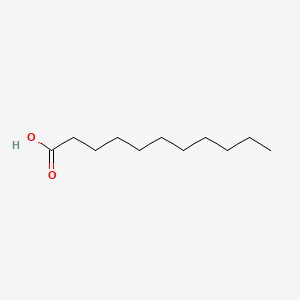| MeSH term | MeSH ID | Detail |
|---|---|---|
| Alopecia | D000505 | 14 associated lipids |
| Hemolysis | D006461 | 131 associated lipids |
UNDECANOIC ACID
UNDECANOIC ACID is a lipid of Fatty Acyls (FA) class. The involved functions are known as Anabolism, Mitosis, Transcriptional Activation, Mismatch Repair and Transcription, Genetic. Undecanoic acid often locates in Protoplasm and spindle microtubule. The associated genes with UNDECANOIC ACID are TERT gene. The related lipids are Fatty Acids and undecanoic acid.
Cross Reference
Introduction
To understand associated biological information of UNDECANOIC ACID, we collected biological information of abnormalities, associated pathways, cellular/molecular locations, biological functions, related genes/proteins, lipids and common seen animal/experimental models with organized paragraphs from literatures.
What diseases are associated with UNDECANOIC ACID?
There are no associated biomedical information in the current reference collection.
Possible diseases from mapped MeSH terms on references
We collected disease MeSH terms mapped to the references associated with UNDECANOIC ACID
PubChem Associated disorders and diseases
What pathways are associated with UNDECANOIC ACID
There are no associated biomedical information in the current reference collection.
PubChem Biomolecular Interactions and Pathways
Link to PubChem Biomolecular Interactions and PathwaysWhat cellular locations are associated with UNDECANOIC ACID?
Visualization in cellular structure
Associated locations are in red color. Not associated locations are in black.
Related references are published most in these journals:
| Location | Cross reference | Weighted score | Related literatures |
|---|
What functions are associated with UNDECANOIC ACID?
Related references are published most in these journals:
| Function | Cross reference | Weighted score | Related literatures |
|---|
What lipids are associated with UNDECANOIC ACID?
Related references are published most in these journals:
| Lipid concept | Cross reference | Weighted score | Related literatures |
|---|
What genes are associated with UNDECANOIC ACID?
Related references are published most in these journals:
| Gene | Cross reference | Weighted score | Related literatures |
|---|
What common seen animal models are associated with UNDECANOIC ACID?
There are no associated biomedical information in the current reference collection.
NCBI Entrez Crosslinks
All references with UNDECANOIC ACID
Download all related citations| Authors | Title | Published | Journal | PubMed Link |
|---|---|---|---|---|
| Trzcinski AP and Stuckey DC | Treatment of municipal solid waste leachate using a submerged anaerobic membrane bioreactor at mesophilic and psychrophilic temperatures: analysis of recalcitrants in the permeate using GC-MS. | 2010 | Water Res. | pmid:19822341 |
| Edelstein D and Basaria S | Testosterone undecanoate in the treatment of male hypogonadism. | 2010 | Expert Opin Pharmacother | pmid:20642374 |
| Touahir L et al. | Localized surface plasmon-enhanced fluorescence spectroscopy for highly-sensitive real-time detection of DNA hybridization. | 2010 | Biosens Bioelectron | pmid:20483582 |
| Sang S and Witte H | A novel PDMS micro membrane biosensor based on the analysis of surface stress. | 2010 | Biosens Bioelectron | pmid:20417086 |
| Matyska MT et al. | Aqueous normal phase retention of nucleotides on silica hydride-based columns: method development strategies for analytes relevant in clinical analysis. | 2010 | J Sep Sci | pmid:20183822 |
| López-GarcÃa I et al. | Liquid-phase microextraction with solidification of the organic floating drop for the preconcentration and determination of mercury traces by electrothermal atomic absorption spectrometry. | 2010 | Anal Bioanal Chem | pmid:20174984 |
| Kalinchenko SY et al. | Effects of testosterone supplementation on markers of the metabolic syndrome and inflammation in hypogonadal men with the metabolic syndrome: the double-blinded placebo-controlled Moscow study. | 2010 | Clin. Endocrinol. (Oxf) | pmid:20718771 |
| Fennell C et al. | Randomized cross-over clinical trial of injectable vs. implantable depot testosterone for maintenance of testosterone replacement therapy in androgen deficient men. | 2010 | Clin. Endocrinol. (Oxf) | pmid:19891698 |
| Christy Hunter A et al. | Transformation of some 3alpha-substituted steroids by Aspergillus tamarii KITA reveals stereochemical restriction of steroid binding orientation in the minor hydroxylation pathway. | 2010 | J. Steroid Biochem. Mol. Biol. | pmid:20026270 |
| Kornmann B et al. | Body fat content and testosterone pharmacokinetics determine gonadotropin suppression after intramuscular injections of testosterone preparations in normal men. | 2009 Sep-Oct | J. Androl. | pmid:19342702 |
